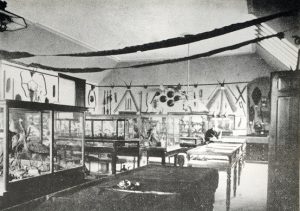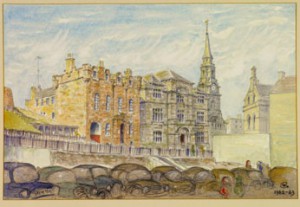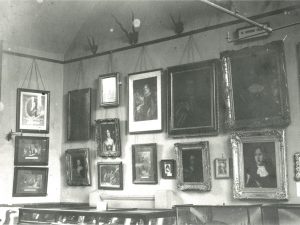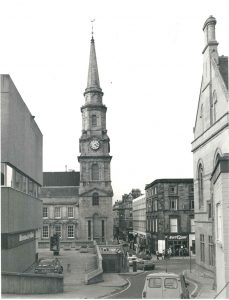Early Days: 1825 – 1835

Inverness Museum displays c.1920s including boa constrictor skins strung across the ceiling
Inverness Museum started life as part of the ‘Northern Institution for the Promotion of Science and Literature’ in 1825. Its first premises were in Inglis street, Inverness. The founder was a young Inverness solicitor called George Anderson.
Early contribution to the collections included a pair of Bishops gloves found in a Crypt at Fortrose and a medallion of Prince Charles for 1745, as well as the more unusual – including the skin of a boa constrictor 24 feet long! In 1835, Hugh Miller, writer and geologist from Cromarty presented “a beautiful and extensive collection of rocks, minerals and fossils from the neighbourhood of Cromarty”.
The Institution held its final meeting in 1835. Over the next 40 years, the museum collections moved, firstly to the Inverness Royal Academy and then the Town Hall.
Inverness Museum : 1876 – 1960

Castle Wynd by William Glashan, c.1960 watercolour showing a view of the old museum building
In 1876 The Inverness Scientific Society and Field Club took responsibility for the surviving museum collections. The collections were by this time in a rather sad state and were in need of a permanent home.Land in Castle Wynd was donated by the Town Council and money was raised by public subscription for a new building. Contributors included Joseph Mitchell (of Highland Railway fame) and Queen Victoria (who donated £50, approx. the equivalent of £6,600 today). Local architect, Alexander Ross, was commissioned to design the building, which was completed in 1881.

Jacobite display at Inverness Museum, including the Bowerbank Collection, c.1920s
The Inverness Fine Arts Exhibition opened in October of that year. It was so popular that it remained open until December, receiving 7000 visitors. The building was opened on a permanent basis in 1882.
In 1905, the museum hosted a Highland & Jacobite Exhibition with almost 1500 items lent by families from all over Scotland. Interestingly, the list includes ‘Isabella Fraser’s Tartan Wedding Dress & Plaid’ which can usually be found in the upstairs gallery at the museum today!
Thomas Wallace became curator in 1907 and he was appointed to run the museum as a Highland and Jacobite collection.

Looking down Castle Wynd towards the Tolbooth Steeple. The new Museum and Art Gallery building is on the left. c.1965
1960s to present
The Castle Wynd and Bridge Street area was cleared for re-development in 1963, and the current complex was built. The museum was housed, along with the town’s library, in a Modernist building of concrete and glass.
Between 1963 and the present day, there have been two major redevelopments to improve the museum. The first, in 1982, incorporated a café, new permanent galleries for the collection and new art galleries for temporary exhibitions. The second refurbishment, in 2007, was completed to coincide with the Year of Highland Culture.

